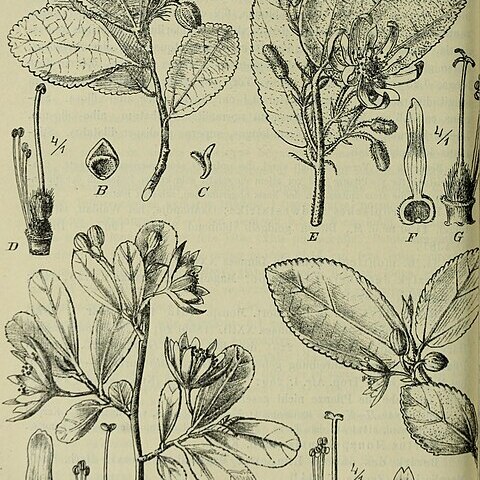A shrub. It grows 1.5 m high. It has several stems. The small branches have a covering of yellowish-brown hairs. The leaf blade is 2-5 mm long by 2-3 mm wide. They are narrowly oval. There are rounded teeth along the edge. There are soft hairs on both surfaces. The flowers are white. Normally 2-3 flowers occur together. The fruit have 4 lobes and are red. They are 2.5 cm across.
Leaf-lamina 2–4·5 mm. × 1·5–3 cm., elliptic to ovate-elliptic, obtuse or acute at the apex, margin crenate-dentate, rounded at the base, softly pubescent on both surfaces; petiole up to 2·5 mm. long, densely pubescent.
Inflorescences terminal and leaf-opposed, 2–3-flowered; peduncles up to 10 mm. long, densely pubescent; pedicels similar, 2–3 mm. long; bracts up to 10 mm. long, pubescent, divided into 2–3 filiform segments.
Petals white, c. 2–3 mm. long, with a shortly triangular lamina and a nectariferous claw larger and wider than the lamina circumvillous within and ledged above.
Androgynophore c. 1·5 mm. long, glabrous at the base, pubescent at the apex at the insertion of the stamens but not elongated.
Sepals up to 17 mm. long, linear-lanceolate, acute at the apex, greenish and tomentellous outside, white and glabrous inside.
Fruit blackish when ripe, up to 2·5 cm. in diam., deeply 4-lobed, rather fleshy, very sparsely setulose.
Rounded bush with yellowish-brown densely pubescent branchlets, glabrescent and dark brown with age.
Shrub, 1 m high. Bracts trifid. Petal lamina 2 mm long ana shortly triangular. Flowers white.
Ovary 4-lobed, villous; style c. 10 mm. long, glabrous; stigma-lobes broad.

